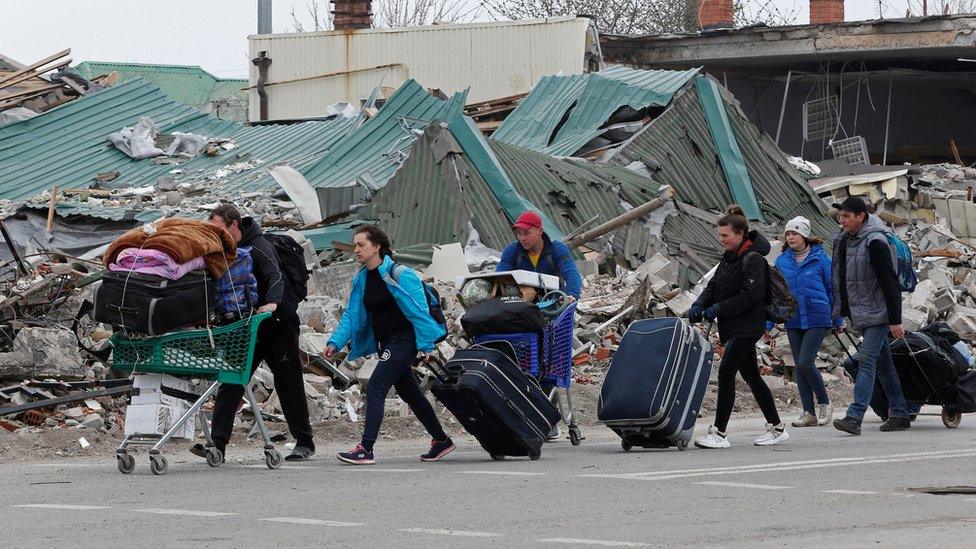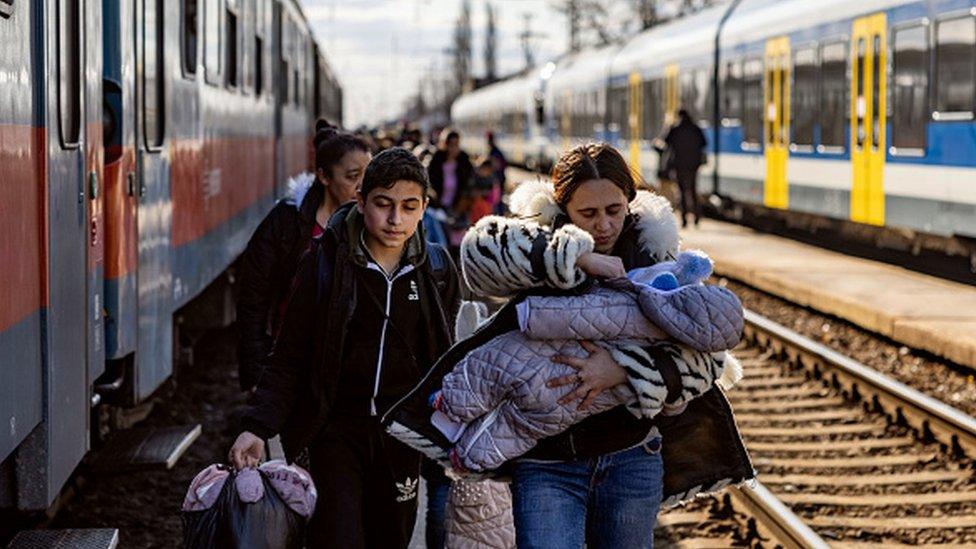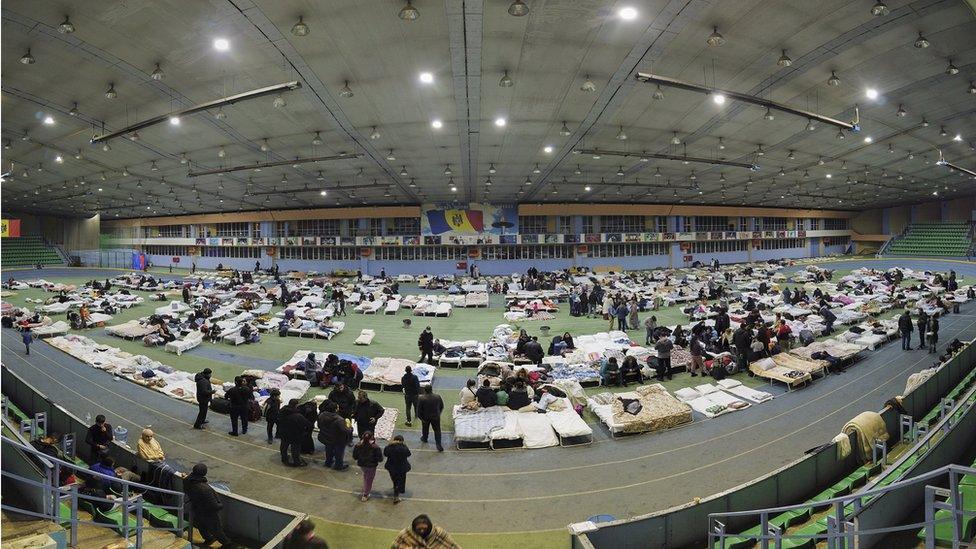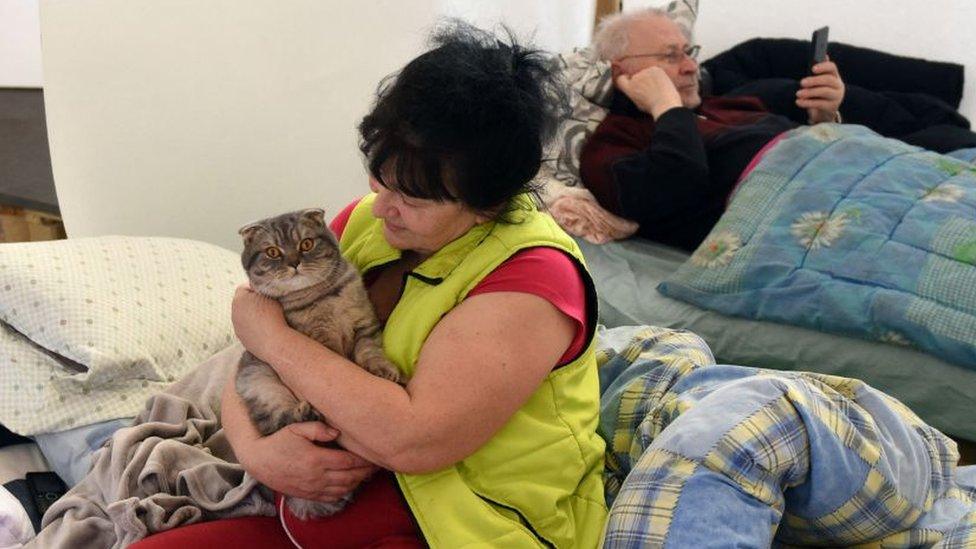How many Ukrainian refugees are there and where have they gone?
- Published

At least 12 million people have fled their homes since Russia's invasion of Ukraine, the United Nations (UN) says.
More than five million have left for neighbouring countries, while seven million people are still thought to be displaced inside Ukraine itself.
However, hundreds of thousands of refugees have returned to their home country - especially to cities like Kyiv.
Where are refugees going?
The UN says that, as of 4 July, external, more than 5.2 million refugees from Ukraine have been recorded across Europe. More than 3.5 million have applied for temporary residence in another country:
Russia: (estimated) 1,412,425 Ukrainian refugees recorded
Poland: 1,194,642
Moldova: 82,700
Romania: 83,321
Slovakia: 79,770
Hungary: 25,800
Belarus: 9,820
Others have moved on to other countries, especially those who crossed into Poland, Hungary and Slovakia. These nations have open borders with other EU states, external.
The UN says there are more than 867,000 Ukrainians in Germany, almost 382,768 in the Czech Republic and 141,562 in Italy.
Some Ukrainians travelled to Russia from the regions of Luhansk and Donetsk, which are now mostly in the hands of pro-Russian separatist forces.
President Vladimir Putin said his forces evacuated 140,000 civilians from Mariupol, external and insisted none of them was forced to go to Russia. However, volunteer groups, external say they have helped thousands of Ukrainians leave Russia.

What help are countries offering refugees?
The EU has granted Ukrainians the automatic right to stay and work throughout its 27 member nations for up to three years.
Refugees are housed in reception centres if they can't stay with friends or relatives. They are given food and medical care, and information about onward travel.
They are entitled to social welfare payments and access to housing, medical treatment and schools.
Poland, one of the countries which has taken the highest number of refugees, and Moldova, which has the largest concentration of refugees by population, have asked for additional support.

Hundreds of refugees were housed in this athletics centre in Moldova
How many people are returning to Ukraine?
The UN says that as of 21 June, there have been over 3 million "cross-border movements" back into Ukraine, external, but says this number does not refer to individual refugees.
Ukraine's border force had previously said people were crossing back into the country at a rate of about 30,000 a day.
Some are returning to areas of Ukraine such as the capital Kyiv, which were threatened by Russian army advances at the start of the war, but which are now considered safer.
In May, Kyiv mayor Vitali Klitschko said the city's population was back to two-thirds of its pre-war level, external.
Where are people fleeing inside Ukraine?
The UN's International Organisation for Migration (IOM) said in May that more than seven million people remain internally displaced, external:
27% of refugees were from the Kharkiv region
16% from Kyiv
16% from the Donetsk region in eastern Ukraine
24% indicated their homes had been damaged or attacked in the war
The IOM estimates that more than half of the people who are internally displaced are women. Many are particularly vulnerable because they are pregnant or have small children, have a disability or are a victim of violence.
The UN is working alongside other organisations to provide cash, food and other supplies.

The UN estimates that about eight million people are displaced inside Ukraine
What is the UK doing to help Ukrainian refugees?
The UK introduced a family visa scheme, external for Ukrainians who have an immediate or extended family member in the UK.
After the government response was criticised, it launched the Homes for Ukraine scheme to allow those without relatives in the UK to settle.
People in the UK can nominate an individual or family to stay with them rent-free for at least six months.
Refugees who come via the scheme can live and work in the UK for up to three years, and get access to healthcare, welfare and schools.
Applications are made online, external, and both hosts and refugees are vetted. Hosts receive £350 a month.
Many families who have applied to be sponsors have complained that the system is too slow and complicated.
As of 28 June, the government had issued 142,500 Ukrainian visas, external out of 161,500 applications received, and as of 27 June, 86,600 visa holders had arrived in the UK.